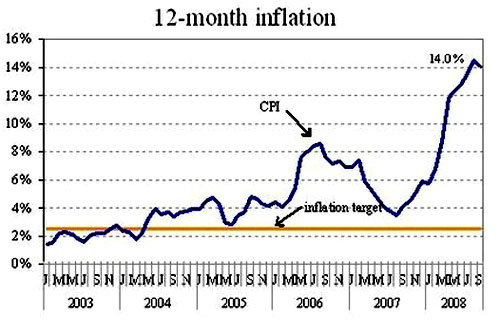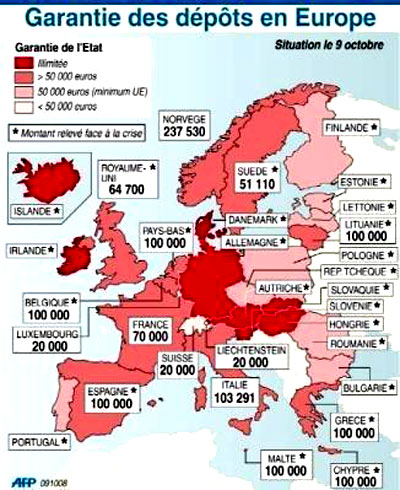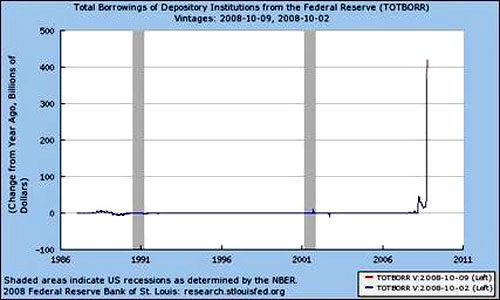
Public announcement GEAB N°28
October 16, 2008
from Leap2020 Website
In this 28th edition of the GEAB (GlobalEurope
Anticipation Bulletin), LEAP/E2020 has decided to launch a new global
systemic crisis alert. Indeed our researchers anticipate that, before next
summer 2009, the US government will default and be prevented to pay back its
creditors (holders of US Treasury Bonds, of Fanny May and Freddy Mac shares,
etc.).
Of course such a bankruptcy will provoke some
very negative outcome for all USD-denominated asset holders.
According to our team, the period that will then
begin should be conducive to the setting up of a «new Dollar» to remedy the
problem of default and of induced massive capital drain from the US.
The process will result from the following five
factors studied in detail further in this GEAB:
-
The recent upward trend of the US Dollar
is a direct and temporary consequence of the collapse of stock
markets
-
Thanks to its recent «political
baptism», the Euro becomes a credible «safe haven» value and
therefore provides a «crisis» alternative to the US dollar
-
The US public debt is now swelling
uncontrollably
-
The ongoing collapse of US real economy
prevents from finding an alternative solution to the country's
defaulting
-
«Strong inflation or hyper-inflation in
the US in 2009?», that is the only question.
Studying the case of Iceland can give an idea of
the upcoming stages of the crisis. That is what our team has been doing ever
since the beginning of 2006. This country indeed provides a good
illustration of what the US and the UK should be expecting.
It can be considered – and that is what most
Icelandic people do today – that the collapse of Iceland's financial system
came from the fact that it was disproportionate to the size of the country's
economy.

Inflation in Iceland -
2003-2008
Source Central Bank of
Iceland
Financially speaking, Iceland thought of itself
as UK (1), in the same way as, financially speaking, UK thought
of itself as the US and the US thought of themselves as the entire world. It
is therefore quite useful to study the case of Iceland (2) in
order to understand the course of events that London and Washington will
follow in the next 12 months (3).
What we see today is a double historical phenomenon:
-
on the one hand, since September 2008
(as anticipated in the February 2008 edition of the GEAB - N°22),
the whole planet has become aware that a global systemic crisis is
unfolding, characterized by the collapse of the US financial system
and its contagion to the rest of the world.
-
on the other hand, a growing number of
global players are beginning to act on their own, in reaction to the
ineffectiveness of the measures advocated or implemented by the US
though they are the centre of this global financial system. What
happened with this first Euroland (or
Eurozone) summit which took
place on Sunday, October 12, 2008, and whose decisions, by their
scope (close to 1,700-billion EUR) and their nature (4),
resulted in a regain of confidence on financial markets from all
over the world, is typical of the «post-September 2008 world».

Map of deposit insurances in
the EU
Source AFP - 10/09/2008
Indeed there is such a thing as a «post-September 2008 world». According to
our team, it is now clear that this past month will remain in the history
books of the whole planet as the month when the global systemic crisis
started; even if what is really at play is its decanting phase, the last of
a series of four phases of the crisis described by LEAP/E2020 as early as
June 2006 (5).
As always when it comes to large human groups,
the perception of change among the general public only occurs when change is
already far on its way.
As a matter of fact, September 2008 is the month when the «financial
detonator» of the global systemic crisis exploded.
According to LEAP/E2020 indeed, this second
semester 2008 is the time when «the world dives into the heart of the impact
phase of the global systemic crisis» (6); which means for our
researchers that, at the end of this semester, the world enters the
«decanting phase» of the crisis, i.e. a phase when the outcome of the shock
settles down.
This phase is the longest (from 3 to 10 years,
according to the country) and the one affecting the largest number of people
and countries. It is also the phase when the components of new global
equilibriums will start to appear, two of them being already described by
LEAP/E2020 in this 28th edition of the GEAB in the graphic illustrations
below (7).
Therefore, as we repeated it on and on since 2006, this crisis is far more
important, in terms of impact and outcome, than the 1929 crisis.
Historically, we are the very first players, witnesses and/or victims of a
crisis affecting the whole planet, in a situation of unprecedented
interdependence of countries (resulting from twenty years of globalization)
and people (the level of urbanization - and related dependence for all the
basic needs - water, food, energy… - is also unprecedented).
However, the 1929 experience and all its
dreadful outcome, is still vivid enough in our collective memories to hope,
if citizens are vigilant and leaders clear-sighted, that we will be spared
from a «remake» leading to major conflagration(s).
Europe, Russia, China, Japan,... are certainly the collective players who
can make sure that the unfolding implosion of today’s world power, i.e. the
United States, does not drive the planet into a disaster. Indeed, except for
Gorbachev’s USSR, empires have a tendency to strive in vain to reverse the
course of History when they realize their might is escaping them.
It then belongs to partner-powers to channel the
process peacefully, as well as it belongs to the citizens and rulers of the
concerned country to be clear-sighted and face the difficult times they are
about to cross.

Total borrowings of US
Depository Institutions from the US Federal Reserve (01/08/1986 –
10/09/2008)
Source Federal Reserve Bank
of St Louis
The «emergency repair» of international
financial channels, achieved by the countries of the Eurozone at the
beginning of this month of October 2008 (8), should not hide
three fundamental facts:
-
The “repair” was necessary to curb the
panic that threatened to squander the entire global financial system
in just a few weeks, but what it heals temporarily is merely a
symptom. It has just bought a bit of time, two to three months
maximum, as the global recession and the collapse of the US economy
(the table above shows the staggering increase of US banks’
borrowings from the Fed) will speed up and create new tensions in
the economic, social and political fields, that must be anticipated
and coped with as soon as next month (as soon as the “financial
packages” have been implemented)
-
The huge financial means allocated
worldwide for «emergency rescues» of the global financial system,
though they were necessary to put back in order the system of
credit, are lost for the real economy when it is on the verge of
facing a global recession
-
The «emergency repair» results in
further marginalization, and therefore weakening, for the United
States, because it sets up processes that are contrary to those
advocated by Washington for the allocation of the Hank Paulson’s and
Ben Bernanke’s 700-billion USD
TARP: bank recapitalization by
governments (a decision Hank Paulson has now come to follow) and
interbank loan guarantees (in fact Euroland governments substitute
to credit insurers, a mostly American industry at the centre of
global finance since decades).
These trends turn more and more
decision-making relays and financial flows away from the
United-States when because of the explosion of their public (9)
and private debt they need them more than ever; not to mention
pensions going up in smoke (10).
The last aspect shows how, in the coming months,
solutions to the crisis and to its various sequences (financial, economic,
social and political) will increasingly diverge: what is good for the rest
of the world will not be good for the United States (11), and
now, Euroland in the first place, the rest of the world seems determined to
make its own choices.
The sudden shock that will result from the US defaulting in summer 2009 is
partly due to this decoupling of decision-making processes of the world’s
largest economies with regard to the US.
It is predictable and can be dampened if global
players start to anticipate it.
As a matter of fact, it is one of the topics
developed in this 28th edition of the GEAB: LEAP/E2020 hopes that the
September shock has “educated” the world’s political, economic and financial
policy-makers and made them understand that it is easier to act by
anticipation than in a panic.
It would be a pity if Euroland, Asia and
oil-producing countries, as well as US citizens of course, discover one
morning of summer 2009 that, after a long-week-end or bank-holiday in the
US, their US T-Bonds and Dollars are only worth 10 percent of their value
because a «new Dollar» has just been imposed (12).
Notes
(1) Iceland adopted 10 years ago all the
principles of economic deregulation and «financieration» advocated and
implemented in the US and UK. Reykjavik thus became some sort of a
financial «Mini-Me» of London and Washington, in reference to the very
Americano-British movie character Austin Powers. The three countries
undertook to play the financial game of «the frog that wished to be as
big as the ox», in reference to a fable by Jean de la Fontaine with a
very unhappy end for the frog.
(2) Icelandic stocks collapsed 76 percent after a few days suspension
designed to «avoid» a panic! Source:
MarketWatch, 10/14/2008
(3) On this subject, let's spend a few lines on the amount of the
“financial package” announced by London, i.e. 640-billion EUR including
64-billion EUR to recapitalize banks and a further 320-billion EUR pay
back those same banks’ debt (source:
Financial Times, 10/09/2008). With
an economy in freefall to the image of the real-estate market, with a
soaring inflation, with capital-based pensions going up in smoke and a
currency at the lowest,… apart from increasing the public debt and
weakening even more the Sterling pound, it is difficult to imagine how
the plan can «rescue» British banks. Contrary to Eurozone banks, the
British financial system, exactly like its US counterpart, is at the
centre of the crisis, not a collateral victim. Gordon Brown may well
compare himself to Churchill and Roosevelt together (Source:
Telegraph,
10/14/2008), in his ignorance of History, he seems to forget that
neither Churchill nor Roosevelt had already spent 10 years in their
country's governments when each of them had to cope with their «big
crisis» (that goes for the US and the Bush administration - Paulson and
Bernanke included - who all come from the problem and are certainly not
part of the solution). Not to mention the fact that Churchill and
Roosevelt organized summits such as Yalta or Tehran leaving the French
and the Germans waiting at the door, while today it is him who waits at
the door of the Euroland summit.
(4) Source:
L'Express, 10/13/2008
(5) Source:
GEAB N°5, May 15, 2006
(6) Source:
GEAB N°26, June 15, 2008
(7) LEAP/E2020 made a synthesis of its anticipations on the decanting
phase of the crisis by means of a world map of the impact of the crisis
based on the identification of 6 large groups of countries; and of an
anticipatory schedule of the 4 financial, economic, social and political
sequences over 2008-2013 for each of these regions.
(8) It is indeed the Eurozone which curbed the spiral of global panic.
For weeks, the US and British initiatives followed one another without
any effect. The eruption of a new collective player, the «Euroland
summit», and the wide-ranging decisions it made, are a new and soothing
phenomenon. It is for this very reason that Washington and London have
systematically prevented such a summit from taking place ever since the
Euro was launched, 6 years ago. A complete set of diplomatic
gesticulation was required (preliminary meeting, pre-summit group
photo,…) to make the British Prime Minister believe he was not set aside
the process, when in fact there is no reason why he should take part in
a Euroland Summit. In this edition of the GEAB, LEAP/E202020 comes back
on the phenomenon and the long-term systemic consequences of this 1st
Euroland Summit.
(9) The US financial rescue plan has already increased by 17,000 USD the
debt owned by each US citizen. Source:
CommodityOnline, 10/06/2008
(10) It is indeed 2,000-billion USD of capital-based pensions which
evaporated in the past few weeks in the US. Source:
USAToday, 10/08/2008
(11) At least in the short-term. Indeed our team is convinced that it is
not bad at all for the American people in the medium- and long-term if
the system currently prevailing in Washington and New-York is
fundamentally reappraised. This system has thrust the country into
dramatic problems among which dozens of millions of US citizens now
struggle, as illustrated in this article by the
New York Times dated
10/11/2008.
(12) Even if it will be a minor-scale measure compared to the prospect
of a US bankruptcy, those who think that it is time to invest again on
financial markets may find useful to learn that the New York Stock
Exchange has recently reviewed all its circuit-breaker thresholds as a
result of ratings collapse. Source:
NYSE/Euronext, 09/30/2008



